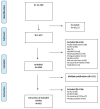Self-Management Interventions for Adults Living with Type II Diabetes to Improve Patient-Important Outcomes: An Evidence Map
- PMID: 38132046
- PMCID: PMC10742682
- DOI: 10.3390/healthcare11243156
Self-Management Interventions for Adults Living with Type II Diabetes to Improve Patient-Important Outcomes: An Evidence Map
Abstract
Self-management interventions (SMIs) may be promising in the treatment of Diabetes Mellitus Type 2 (T2DM). However, accurate comparisons of their relative effectiveness are challenging, partly due to a lack of clarity and detail regarding the intervention content being evaluated. This study summarizes intervention components and characteristics in randomized controlled trials (RCTs) related to T2DM using a taxonomy for SMIs as a framework and identifies components that are insufficiently incorporated into the design of the intervention or insufficiently reported. Following evidence mapping methodology, we searched MEDLINE, CINAHL, Embase, Cochrane, and PsycINFO from 2010 to 2018 for randomized controlled trials (RCTs) on SMIs for T2DM. We used the terms 'self-management', 'adult' and 'T2DM' for content. For data extraction, we used an online platform based on the taxonomy for SMIs. Two independent reviewers assessed eligible references; one reviewer extracted data, and a second checked accuracy. We identified 665 RCTs for SMIs (34% US, 21% Europe) including 164,437 (median 123, range 10-14,559) adults with T2DM. SMIs highly differed in design and content, and characteristics such as mode of delivery, intensity, location and providers involved were poorly described. The majority of interventions aimed to improve clinical outcomes like HbA1c (83%), weight (53%), lipid profile (45%) or blood pressure (42%); 27% (also) targeted quality of life. Improved knowledge, health literacy, patient activation or satisfaction with care were hardly used as outcomes (<16%). SMIs most often used education (98%), self-monitoring (56%), goal-setting (48%) and skills training (42%) to improve outcomes. Management of emotions (17%) and shared decision-making (5%) were almost never mentioned. Although diabetes is highly prevalent in some minority groups, in only 13% of the SMIs, these groups were included. Our findings highlight the large heterogeneity that exists in the design of SMIs for T2DM and the way studies are reported, making accurate comparisons of their relative effectiveness challenging. In addition, SMIs pay limited attention to outcomes other than clinical, despite the importance attached to these outcomes by patients. More standardized and streamlined research is needed to better understand the effectiveness and cost-effectiveness of SMIs of T2DM and benefit patient care.
Keywords: diabetes type 2; evidence mapping; quality improvement; self-management interventions.
Conflict of interest statement
Author Oliver Groene was employed by the company OptiMedis. The remaining authors declare that the research was conducted in the absence of any commercial or financial relationships that could be construed as a potential conflict of interest.
Figures






References
-
- WHO . Global Action Plan for the Prevention and Control of NCDs 2013–2020. World Health Organization; Geneva, Switzerland: 2013.
-
- Glasgow R.E., Eakin E.G. Issues in Diabetes Self-Management. The Handbook of Health Behavior Change. 2nd ed. Springer Publishing Company; New York, NY, USA: 1998. pp. 435–461.
-
- Peyrot M., Rubin R.R., Lauritzen T., Snoek F.J., Matthews D.R., Skovlund S.E. Psychosocial problems and barriers to improved diabetes management: Results of the Cross-National Diabetes Attitudes, Wishes and Needs (DAWN) Study. Diabet. Med. 2005;22:1379–1385. doi: 10.1111/j.1464-5491.2005.01644.x. - DOI - PubMed
Publication types
Grants and funding
LinkOut - more resources
Full Text Sources

